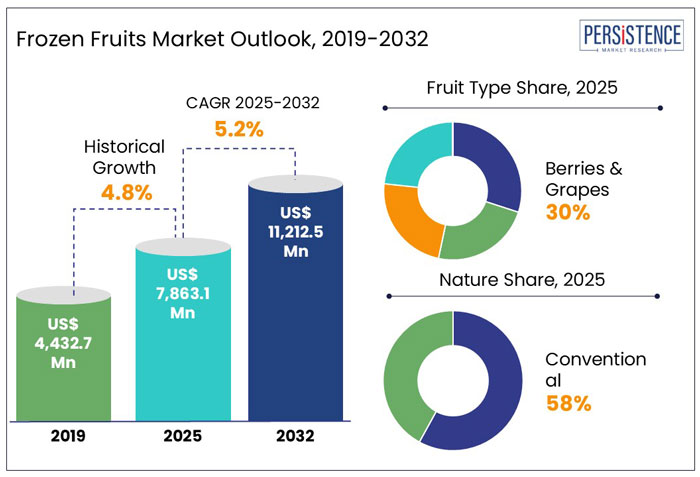Industry: Food and Beverages
Published Date: March-2025
Format: PPT*, PDF, EXCEL
Delivery Timelines: Contact Sales
Number of Pages: 246
Report ID: PMRREP10729
The global frozen fruits market is expected to grow from US$ 7,863.1 in 2025 to US$ 11,212.5 Mn in 2032, at a substantial CAGR of 5.2% from 2025 to 2032.

|
Frozen Fruits Market Size (2025E) |
US$ 7,863.1 Mn |
|
Projected Sales of Frozen Fruits (2032F) |
US$ 11,212.5 Mn |
|
Value CAGR (2025-2032) |
5.2% |
|
Value Share of Top 4 Countries (2024E) |
58% |
The global frozen fruits market has witnessed significant growth in the historical period registering a CAGR of 5.0% in the historical period and was valued at US$ 7,863.1 Mn in 2025. The market is expected to grow steadily with increasing awareness and benefits about applications of frozen fruits.
Frozen fruits are defined as fruits which are maintained at a temperature at which all the moisture is in the solid state. These fruits are kept at a temperature below -9.5 degree Celsius to prevent the growth of microorganisms. This helps slow down the process of decomposition and in turn helps to keep the fruits fresh for a longer time period. Frozen fruits contain high level of essential vitamins and potentially healthy antioxidants than the fresh ones.
There are basically two methods used for producing frozen fruits:
As the health and nutrition factor would continue to dominate consumer food preferences, rising frozen fruits consumption is expected to drive the market over the coming years. The global market for frozen fruits is estimated to reach an approximate valuation of US$ 7,538.9 Mn in the forecast period.
The rising demand for ready-to-blend frozen smoothie packs is emerging as a major trend in the frozen fruits market, primarily fueled by growing consumer preference for convenience in healthy eating. As consumers increasingly prioritize health and wellness, especially in urban areas, they are shifting towards quick and nutritious meal options like smoothies.
A major driver behind this trend is the increasing demand for plant-based, clean-label, and organic beverages, where smoothies made from frozen fruits with no preservatives or added sugar are gaining immense popularity. Additionally, many online grocery platforms and supermarket chains are expanding their offerings of frozen fruit smoothie packs, often tailored for specific health benefits such as immunity-boosting, energy-enhancing, or gut-health improvement. Moreover, the influence of social media and fitness influencers promoting smoothies as healthy breakfast options or post-workout meals has significantly driven the sales of ready-to-blend frozen smoothie packs.
Furthermore, innovative product offerings like customizable frozen smoothie kits or superfood-infused fruit blends are also gaining momentum. Brands are now offering flavor combinations such as strawberry-banana with chia seeds, blueberry-spinach with flax seeds, or mango-pineapple with ginger to cater to diverse taste preferences.
The rising demand for non-seasonal fruits is significantly driving the growth of the frozen fruit market, as consumers seek year-round access to fruits that are typically only available during specific seasons. Factors such as growing health consciousness, increasing preference for convenient and nutrient-dense food options, and evolving dietary patterns have contributed to this trend. Consumers now expect to enjoy summer fruits like mangoes, berries, and cherries even during winter, prompting manufacturers to cater to this demand by offering frozen alternatives that retain maximum freshness, taste, and nutritional value.
The increased demand for industrial goods like fruit cups, prepared salads, and similar food items is attributed to factors such as the rising global urban population and per capita income.
The demand for frozen fruits from food producers is rising globally as these purchasers buy processed fruit goods from industry players, including dairy companies and confectionery and bakery businesses, to use fruits in their production processes.
Changing consumer purchasing patterns are emerging as a significant restraint for the frozen fruits market, primarily due to shifting preferences towards fresh and locally sourced produce, reducing the demand for frozen alternatives. With increasing consumer awareness about the farm-to-table concept, many consumers now prefer purchasing fresh fruits from local farmers' markets, organic stores, and fresh produce sections in supermarkets rather than opting for frozen packaged fruits. This shift is primarily driven by the perception that fresh fruits offer superior taste, texture, and nutritional value, limiting frozen fruit sales' growth potential.
Additionally, the growing trend of daily grocery shopping, especially in urban areas, is impacting the long-term storage of frozen fruits in households. Consumers now prefer purchasing small, fresh fruit batches that align with their daily meal preparation needs, reducing the reliance on frozen fruit stockpiling.
The perception of nutrient loss in frozen fruits remains a significant restraint hindering the growth of the frozen fruit market, despite substantial advancements in flash-freezing technology. Many consumers still believe that frozen fruits have inferior nutritional value compared to fresh produce, deterring them from purchasing frozen alternatives. This perception is rooted in the traditional belief that fresh fruits retain higher vitamins, antioxidants, and natural flavors, whereas freezing may diminish their health benefits.
Additionally, consumers often associate frozen fruits with highly processed foods, assuming they contain preservatives or artificial ingredients, despite the fact that most frozen fruits are flash-frozen without additives. This perception is particularly evident among health-conscious consumers, fitness enthusiasts, and clean-label product advocates, limiting the potential demand for frozen fruit products.
The European frozen fruits market is experiencing a remarkable boom, driven by several interlinked factors shaping consumer preferences and market dynamics. One of the primary drivers is the growing demand for year-round availability of fruits, particularly non-seasonal and exotic varieties. With changing climate conditions and shorter growing seasons, consumers increasingly turn to frozen fruits to meet their dietary needs without compromising quality or availability. Additionally, the European region has a rising trend in health-conscious consumers who prioritize nutrient-dense, minimally processed foods, making frozen fruits a preferred option due to their longer shelf life and preserved nutritional value.
The expansion of the retail sector, particularly in Germany, France, and the UK, has further propelled the demand for frozen fruits. Supermarkets and hypermarkets now offer an extensive range of frozen fruit products, often marketed for smoothies, desserts, and breakfast bowls. According to Poland export reports, Poland has emerged as a major frozen fruit exporter, driven by high demand from Western European countries.
The outlook for the U.S. frozen fruits market appears highly promising, driven by shifting consumer preferences, expanding product offerings, and growing demand for convenient and nutritious food options. One of the key factors propelling market growth is the rising health consciousness among American consumers, who are increasingly opting for nutrient-dense food choices. Frozen fruits, known for their longer shelf life and preserved nutritional value, have become a staple for households, particularly for preparing smoothies, desserts, and quick meal solutions. Additionally, the demand for non-seasonal fruits has significantly increased, as consumers seek a variety of fruits such as berries, mangoes, and pineapples throughout the year.
The berries and grapes segment by fruit type is dominating the frozen fruits market due to their widespread popularity, high nutritional value, and versatile applications in various food and beverage products. Berries, including strawberries, blueberries, raspberries, and blackberries, are particularly favored for their rich antioxidant content, low calories, and immune-boosting properties. Similarly, grapes, especially seedless and table varieties, are in high demand for frozen applications like smoothies, fruit blends, bakery products, and snacks. Consumers increasingly prioritize health-conscious diets, with a growing preference for foods that offer natural vitamins, antioxidants, and fiber, positioning berries and grapes as prime choices in the frozen fruit market.
Another driving factor is the surge in demand for ready-to-use fruit solutions among food service outlets such as bakeries, juice bars, and dessert chains. Frozen berries and grapes serve as convenient ingredients for preparing smoothies, yogurt toppings, cakes, and fruit salads, significantly boosting their market share.
The pulp & puree form in the frozen fruit market is expected to witness a major Compound Annual Growth Rate (CAGR) due to its increasing demand across the food and beverage industry, particularly for manufacturing juices, smoothies, sauces, baby food, and dairy products. One of the primary growth drivers is the rising consumption of fruit-based beverages, such as fruit juices, mixed fruit smoothies, and pulp-based beverages, which have gained immense popularity among health-conscious consumers. As consumers shift toward natural and preservative-free products, frozen fruit pulp and puree have emerged as ideal ingredients for delivering natural flavor, color, and nutrition in various food applications.
Another major factor contributing to the higher CAGR of pulp & puree is its widespread utilization in the food service industry, including quick-service restaurants (QSRs), dessert outlets, and juice bars.

The key manufacturers in the region are focusing on optimizing supply chains while ramping up production to cater to the rising demand in the market. The producers implement strategic partnerships, including takeovers, joint ventures, and mergers, to maintain a significant footprint while venturing into new markets to attract more customers.
|
Attribute |
Details |
|
Forecast period |
2025-2032 |
|
Historical data available for |
2019-2024 |
| Market Analysis Units | Value: US$ Bn/Mn, Volume: As applicable |
|
Key regions covered |
|
|
Key countries covered |
|
|
Key market segments covered |
|
|
Key companies profiled |
|
| Report Highlights |
|
|
Customization & pricing |
Available upon request |
By Fruit Type:
By End Use:
By Form:
By Nature:
By Distribution Channel:
By Region:
To know more about delivery timeline for this report Contact Sales

The global market for frozen fruits has a value of US$ 7,863.1 Mn in 2025.
The global market for frozen fruits has a value CAGR of 5.0% from 2019-2024.
The global market for frozen fruits has a value of US$ 11,212.5 Mn in 2032.
The global market for frozen fruits has a value CAGR of 5.2% from 2025-2032.
Kerry Group PLC, Agrana Beteiligungs AG, Welch Foods Inc., SunOpta Inc, and Ardo NV are the few of the prime players leading the frozen fruits market.